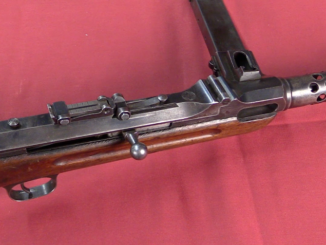4x Nagoya: https://www.rockislandauction.com/detail/69/1441
2.5x Kokura: https://www.rockislandauction.com/detail/69/1446
The Japanese Army made significant use of snipers (or in today’s terminology, designated marksmen) as part of its infantry combined arms doctrine, and produced about 22,000 Type 97 sniper rifles for use in WWII and the Sino-Japanese War. In 1941, shortly after the adoption of the new 7.7mm rifle cartridge, it was decided that a sniper rifle variant of the Type 99 should be made in addition to the Type 97 (which was basically a scoped Type 38).
Testing through 1941 determined that there was almost no practical difference in accuracy between scoped examples of the Type 99 long and short rifles, and so the short rifle was chosen to be the basis for the Type 99 sniper (the Type 99 long rifles would drop from production altogether pretty quickly anyway). About 1,000 of the scoped 99s were manufactured by the Kokura Arsenal using the same 2.5x scope as on the Type 97 sniper, while the Nagoya Arsenal instead used a 4x scope, offering more magnification at the expense of a narrower field of view. Nagoya would produce approximately 10,000 of these rifles, with 4x scopes except for a period between serial numbers 5,000 and 7,000 with 2.5x scopes (most likely the remainder stored at Kokura when that plant ceased production). The rifles made into snipers were given no special selection criteria; simply taken at random from normal production. The utility of the weapon in Japanese practice came not from it being mechanically more accurate than any other issue rifle, but rather from the optical sight allowing better exploitation of that standard rifle’s inherent accuracy.



If the trend of terrible logistics continued, the scope and rifle pair would hardly match. However the Japanese decided not to fix a gun that wasn’t broken. They just found a cheap way to get slightly better results out of a decent rifle. I don’t think that the speed limit on bolt cycling would lessen the danger at the receiving end, since the sender is likely not to advertise his presence… or am I wrong?
I quess the mismatch was done after the war, as the rifles came with scopes from factory, and each scope was zeroed for specific rifle.
Here’s the problem: The Imperial Japanese Army tended to ship the scopes and rifles in separate crates on separate boats!
I read somewhere these rifles were zeroed at the factory and shipped with no adjustment ability. Is that correct? Seems a tad clumsy.
If the idea was to get better results from a standard rifle, one wonders why they didn’t try to do it with all their infantry rifles. Maybe cost or capacity to produce the needed number of scopes. But, it seems like a step in the direction where current infantry have something like an ACOG on their rifles.
They have no external adjustments, but they can be zeroed by an armorer with special tools (rather like the German ZF-41).
Just wanted to say how much I love your articles. I’ve just started getting my WWII firearms collection going and have a type 38 arisaka and type 99 arisaka (last ditch) that I absolutely love. Can’t wait to see what other awesome firearms you show next.
It is definitely old news that the Type 99 Arisaka is my favorite WWII rifle bar none. P. O. Ackley tested all the various military rifles from that era and concluded that the Type 99 action was the strongest of the lot. I do not like the original scopes but with an altered bolt handle and a modern scope they are unbeatable as originals and as sporterized hunting rifles. My last qualification in the Marines was with the Rem. M-40X in .300 Win. Mag. fired at Camp Shelby, Miss. It was accurate out to about 1500 meters. After qualification with it, I repeated the course out to 500+ meters with my early-era Type 99 (Chrome-lined barrel, anti-aircraft sights and mono-pod) equipped with a modern Weaver 3-9X variable in the original stock shooting precision hand-loads and was only 3 points behind the M-40X equipped with its Fecker scope. The original scopes were lacking in comparative quality but these rifles, in the hands of a veteran of protracted combat, were deadly. In the words of our Gunny, “If they could see you they could kill you.” That’s all that counts in combat.
Amen to that. Thanks for the info, Bill.
Great information, Bill — thanks very much. I have always liked the Arisaka rifles in both the 6.5mm and 7.7mm variants, and feel that they are still largely misunderstood and grossly under-estimated even today by those who should know better, no thanks in part to wartime propaganda that persists to the present time in some quarters.